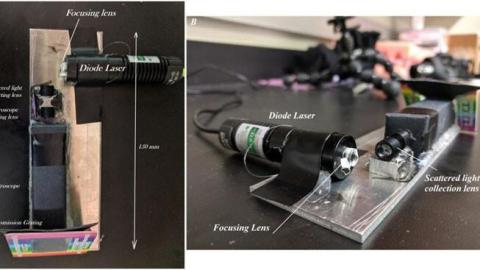For $50, convert your phone into a powerful chemical, pathogen detector

- Spectroscopy provides a non-invasive way to study the chemical composition of matter.
- These techniques analyze the unique ways light interacts with certain materials.
- If spectrometers become a common feature of smartphones, it could someday potentially allow anyone to identify pathogens, detect impurities in food, and verify the authenticity of valuable minerals.
The quality of smartphone cameras has increased exponentially over the past decade. Today’s smartphone cameras can not only capture photos that rival those of stand-alone camera systems but also offer practical applications, like heart-rate measurement, foreign-text translation, and augmented reality.
What’s the next major functionality of smartphone cameras? It could be the ability to identify chemicals, drugs, and biological molecules, according to a new study published in the Review of Scientific Instruments.
The study describes how a team of scientists at Texas A&M turned a common smartphone into a “pocket-sized” Raman and emission spectral detector by modifying it with just $50 worth of extra equipment. With the added hardware, the smartphone was able to identify chemicals in the field within minutes.
The technology could have a wide range of applications, including diagnosing certain diseases, detecting the presence of pathogens and dangerous chemicals, identifying impurities in food, and verifying the authenticity of valuable artwork and minerals.
Raman and fluorescence spectroscopy
Raman and fluorescence spectroscopies are techniques for discerning the chemical composition of materials. Both strategies exploit the fact that light interacts with certain types of matter in unique ways. But there are some differences between the two techniques.
As the name suggests, fluorescence spectroscopy measures the fluorescence — that is, the light emitted by a substance when it absorbs light or other electromagnetic radiation — of a given material. It works by shining light on a material, which excites the electrons within the molecules of the material. The electrons then emit fluorescent light toward a filter that measures fluorescence.
The particular spectra of fluorescent light that’s emitted can help scientists detect small concentrations of particular types of biological molecules within a material. But some biomolecules, such as RNA and DNA, don’t emit fluorescent light, or they only do so at extremely low levels. That’s where Raman spectroscopy comes into play.
Raman spectroscopy involves shooting a laser at a sample and observing how the light scatters. When light hits molecules, the atoms within the molecules vibrate and photons get scattered. Most of the scattered light is of the same wavelength and color as the original light, so it provides no information. But a tiny fraction of the light gets scattered differently; that is, the wavelength and color are different. Known as Raman scattering, this is extremely useful because it provides highly precise information about the chemical composition of the molecule. In other words, all molecules have a unique Raman “fingerprint.”
Creating an affordable, pocket-sized spectrometer
To build the spectrometer, the researchers connected a smartphone to a laser and a series of plastic lenses. The smartphone camera was placed facing a transmission diffraction grating, which splits incoming light into its constituent wavelengths and colors. After a laser is fired into a sample, the scattered light is diffracted through this grating, and the smartphone camera analyzes the light on the other side.

To test the spectrometer, the researchers analyzed a range of sample materials, including carrots and bacteria. The laser used in the spectrometer emits a wavelength that’s readily absorbed by the pigments in carrots and bacteria, which is why these materials were chosen.
The results showed that the smartphone spectrometer was able to correctly identify the materials, but it wasn’t quite as effective as the best commercially available Raman spectrometers. The researchers noted that their system might be improved by using specific High Dynamic Range (HDR) smartphone camera applications.
Ultimately, the study highlights how improving the fundamentals of a technology, like smartphone cameras, can lead to a surprisingly wide range of useful applications.
“This inexpensive yet accurate recording pocket Raman system has the potential of being an integral part of ubiquitous cell phones that will make it possible to identify chemical impurities and pathogens, in situ within minutes,” the researchers concluded.





